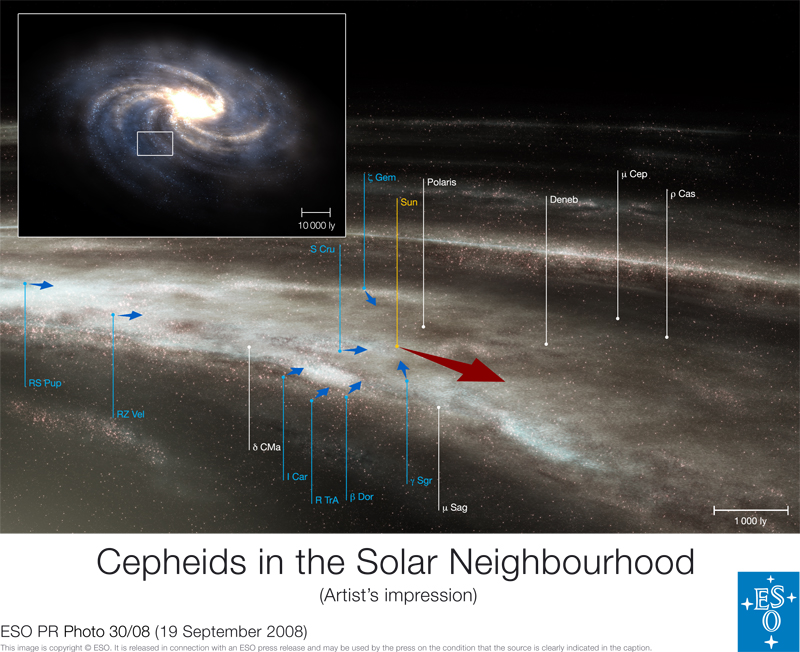Cepheid variable stars have been used for years as a way to determine distance to other galaxies. The correlation between their period of variability and absolute luminosity provides a cosmic yardstick to measure distances out to a few tens of millions of light-years. Additionally, Cepheids closer to home are used as tools to investigate how the Milky Way spins. But the motion of the Cepheids in our galaxy has confused astronomers, as these neighborhood Cepheids appear to fall towards the sun. A debate has raged for decades as to whether this phenomenon was truly related to the actual motion of the Cepheids and, consequently, to a complicated rotating pattern of our galaxy, or if it was the result of effects within the atmospheres of the Cepheids. But new observations with the HARPS (High Accuracy Radio Velocity Planet Searcher) spectograph shows that the Cepheids aren’t falling, and that the much debated, apparent ‘fall’ does in fact stem from properties of the atmospheres around these variable stars.
“The motion of Milky Way Cepheids is confusing and has led to disagreement among researchers,” says astrophysicist Nicolas Nardetto. “If the rotation of the Galaxy is taken into account, the Cepheids appear to ‘fall’ towards the Sun with a mean velocity of about 2 km/s.”
Nardetto and his colleagues observed eight Cepheids with the high precision HARPS spectrograph, attached to the 3.6-m ESO telescope at La Silla, 2400 m up in the mountains of the Chilean Atacama Desert. HARPS, or the High Accuracy Radial Velocity Planetary Searcher, is best known as a very successful planet hunter, but it can also be used to resolve other complicated cases, where its ability to determine radial velocities – the speed with which something is moving towards or away from us – with phenomenally high accuracy is invaluable. “Our observations show that this apparent motion towards us almost certainly stems from an intrinsic property of Cepheids,” says Nardetto.
The astronomers found that the deviations in the measured velocity of Cepheids were linked to the chemical elements in the atmospheres of the Cepheids considered. “This result, if generalized to all Cepheids, implies that the rotation of the Milky Way is simpler than previously thought, and is certainly symmetrical about an axis,” concludes Nardetto.
Source: ESO


Hi Nancy.
I’m confused, the Name cepheids is realy
an terminollegy for an objet is it not?
We use this (object) as a reference point to estimate a probabel distance? At least that is my understanding of this artical. If I may make an anology, When we measure a distance from point A to point B we have an absolute distance yes? Now we are taken
a measurement in the realm of space,
we can not take tape measure and walk from Earth to where ever yes/ At least not jet.
Since everything is moving, and I mean moving sometimes at light speed but because of the fast distances the objects
seams to be relatively standing still! Try taking a measurement from a moving bullet train from the point at the station where you are standing with a tape measure? It will not work right? The astro people say that the distance from earth to the moon is …..miles/
kilometers? We had the oppertunity to go to the moon and we were able to verify that?
Here on earth we use telemetry to determine
distanses and angles, BUT the objects are standing still. I do understand that you can do
a measurement relative to?Just like the days in school when we set out distances playing
by simply using our foot as a measuring guide. I do except the distances we the astro community is giving use, BUT they are certainly not absolute, right? These measurement are by observation and imaginary values yes? May I humbly propose
That we use a symbol when giving distances
and speeds in the astronomical community
Such as ^[……..]^ ? From your artical I have the impression that Cepheids are used as refference (yard sticks) yes? The distances
between Cepheids or the distances them and Earth? Are they (trajectory or point to point? Cepheids used as a yardstick, without
having a scaling is really compounding the
error and therefore not realistic yes?
Pease forgive me if I’m sound synical, it is not my intension. Like I said from the start, I’m
confused as to what the artical is saying?
The Astro community is an undiciplend at best, one should follow certain standarts
or general conformmity, so we all can understand as to what they are saying, right?
Respectfully Yours.
I am not an astronomer so I too have had some troubles understanding this article.
If the composition of the cepheid atmospheres are responsible for the “falling” artifact then I have to ask what is the chemistry of these atmospheres and why is distributed among these stars such that this artifact is visible in the first place. I would have thought that the atmospheric composition would be randomly distributed thus giving the illusion that these variable stars would be falling in random directions. Since they do appear to us as if they are falling towards the Sun would an astronomer on one of the other galactic arms of the Milky Way see these cepheids appear to fall towards themselves or towards our Sun?
There seems to be some background information missing in your article that would go a long way to explaining the significance of these findings to those of us who are not formally trained in astronomy.
“The astronomers found that the deviations in the measured velocity of Cepheids were linked to the chemical elements in the atmospheres of the Cepheids considered. ”
Was the velocity measured through redshift? If so, this seems to be saying that there is an intrinsic component to redshift, right? If there is an intrinsic component then all of redshift based distances could be wrong … right?